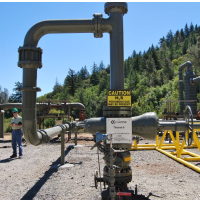Study Suggests Oklahoma Earthquakes Due to Oil Drilling Waste Disposal
 Injection eell (photo: KQEDQuest)
Injection eell (photo: KQEDQuest)
A seismologist from the University of Oklahoma says that contributing factors in the state’s recent problems with earthquakes are injection wells, which industry uses to extract oil and gas from depleted reservoirs or to store toxic waste fluid produced during drilling, such as hydraulic fracturing (a.k.a. fracking).
Professor Katie Keranen’s findings are just the latest evidence suggesting that injection and disposal wells can cause increases in seismic activity, even in regions not usually impacted by earthquakes.
The research focused on the 5.7 magnitude quake that hit near Prague, Oklahoma, on November 6, 2011, the largest ever recorded by modern instruments in the state and the largest triggered by injection wells to date, according to the research. The quake injured two people and destroyed 14 homes.
On March 22, the Oklahoma Geological Survey issued a statement that the Prague earthquake was “the result of natural causes.”
The year 2011 saw more than 1,400 earthquakes, the most ever recorded in Oklahoma.
-Noel Brinkerhoff
To Learn More:
Oklahoma Earthquake Was Largest Linked to Injection Wells, New Study Suggests (by Joe Wertz, State Impact-NPR)
Potentially Induced Earthquakes In Oklahoma, USA: Links Between Wastewater Injection And The 2011 Mw 5.7 Earthquake Sequence (Katie M. Keranen, Heather M. Savage, Geoffrey A. Abers and Elizabeth S. Cochran, Geology) (pdf)
Fracking Suspected in Rash of Earthquakes in Unlikely Places (by Noel Brinkerhoff and David Wallechinsky, AllGov)
- Top Stories
- Unusual News
- Where is the Money Going?
- Controversies
- U.S. and the World
- Appointments and Resignations
- Latest News
- Trump to Stop Deportations If…
- Trump Denounces World Series
- What If China Invaded the United States?
- Donald Trump Has a Mental Health Problem and It Has a Name
- Trump Goes on Renaming Frenzy






Comments